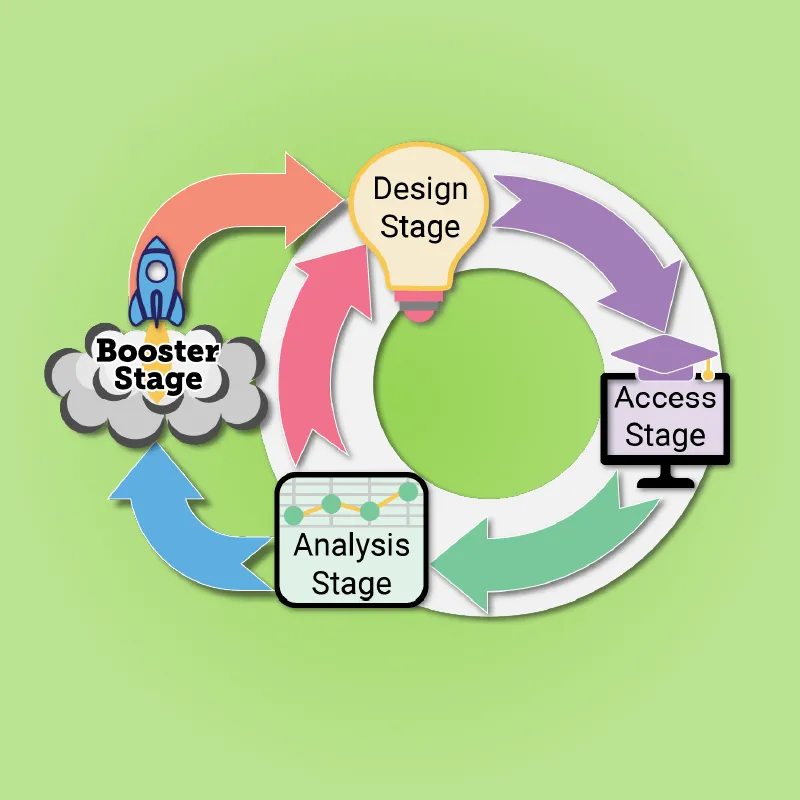Agile Design for Rapid, High-Impact Curriculum Development
Quickly delivering essential learning material for a technical subjects by continuously iterating based on learner feedback.


How can we deliver high-impact curriculum material without spending months on analysis and mapping?
The All of Us Research Program is advancing genomic research to improve precision medicine. However, as genetics became a core focus, the training needs analysis revealed a knowledge gap: Many staff members lacked foundational genetics education, making it difficult for them to discuss genetic research even when given “talking points.” Completing a full analysis of the subject before beginning development (as in the ADDIE model) would delay delivery indefinitely.
Genetics is a very challenging subject for training. Not only does it include complex topic that require deep knowledge (e.g., inheritance), but those topics intersect with considerations that require accuracy (e.g., health insurance regulation) and sensativity (e.g., informed consent). Analyzing the curriculum and mapping a complete set of learning objectives would have taken months, time the program didn’t have.
How can we deliver high-impact curriculum material without spending months on analysis and mapping?
The All of Us Research Program is advancing genomic research to improve precision medicine. However, as genetics became a core focus, the training needs analysis revealed a knowledge gap: Many staff members lacked foundational genetics education, making it difficult for them to discuss genetic research even when given “talking points.” Completing a full analysis of the subject before beginning development (as in the ADDIE model) would delay delivery indefinitely.
Genetics is a very challenging subject for training. Not only does it include complex topic that require deep knowledge (e.g., inheritance), but those topics intersect with considerations that require accuracy (e.g., health insurance regulation) and sensativity (e.g., informed consent). Analyzing the curriculum and mapping a complete set of learning objectives would have taken months, time the program didn’t have.
Rather than following a traditional waterfall model (e.g., ADDIE) that could delay training delivery for many months, I used an agile-inspired approach to deliver a minimimul-viable product in just weeks, then iteratively improved the curriculum using learner feedback to ensure development remaind needs-driven.
I designed an agile-inspired workflow to rapidly develop the material needed most by learners and stakholders.
Using this agile workflow, we launched the first learning activities in just a few weeks. Testing and feedback guided improvements to existing content and expantion to cover more of the needs and objectives. Within a year, we saw a significant improvement in the staff's overall ability to achive the program's goals in this area.
The program provided a progressive curriculum designed to meet learners at different levels of understanding:
To further accelerate the delivery of instructional material, I designed the foundational curriculum—Genetics 101—to leverage existing educational resources publicly available online. Institutions like the Genetic Science Learning Center and PBS have many accessible and accurate learning activities on their websites. Genetics 101 organized the best of these activities into modules based on topics learners would need to address.
Rather than following a traditional waterfall model (e.g., ADDIE) that could delay training delivery for many months, I used an agile-inspired approach to deliver a minimimul-viable product in just weeks, then iteratively improved the curriculum using learner feedback to ensure development remaind needs-driven.
I designed an agile-inspired workflow to rapidly develop the material needed most by learners and stakholders.
Using this agile workflow, we launched the first learning activities in just a few weeks. Testing and feedback guided improvements to existing content and expantion to cover more of the needs and objectives. Within a year, we saw a significant improvement in the staff's overall ability to achive the program's goals in this area.
The program provided a progressive curriculum designed to meet learners at different levels of understanding:
To further accelerate the delivery of instructional material, I designed the foundational curriculum—Genetics 101—to leverage existing educational resources publicly available online. Institutions like the Genetic Science Learning Center and PBS have many accessible and accurate learning activities on their websites. Genetics 101 organized the best of these activities into modules based on topics learners would need to address.
Regular Needs Assessment surveys were used to track progress in a number of areas of development. Each assessment ask learners to assess their level of confidence in different learning domains. At the same time, learners were encouraged to share all the difficult questions they encountered while in the field interacting with members of the public.
In the year following the first Booster Stage launching the development of the new Genetics curriculum, The number of learners who felt very confident or confident discussing genetic-related topics increased by 11%. We considered this a successful launch of the foundational curriculum, but also indicated that cotinuing to expand the curriculum was important.
When considering all of the difficult questions learners encountered in the field, the share of those questions related to genetics decreased by 19% in that first year. This indicated that the curriculum was successfully addressing the most critical needs of learners. The curriculum was also expanded to include more specific questions and topics commonly enountered.